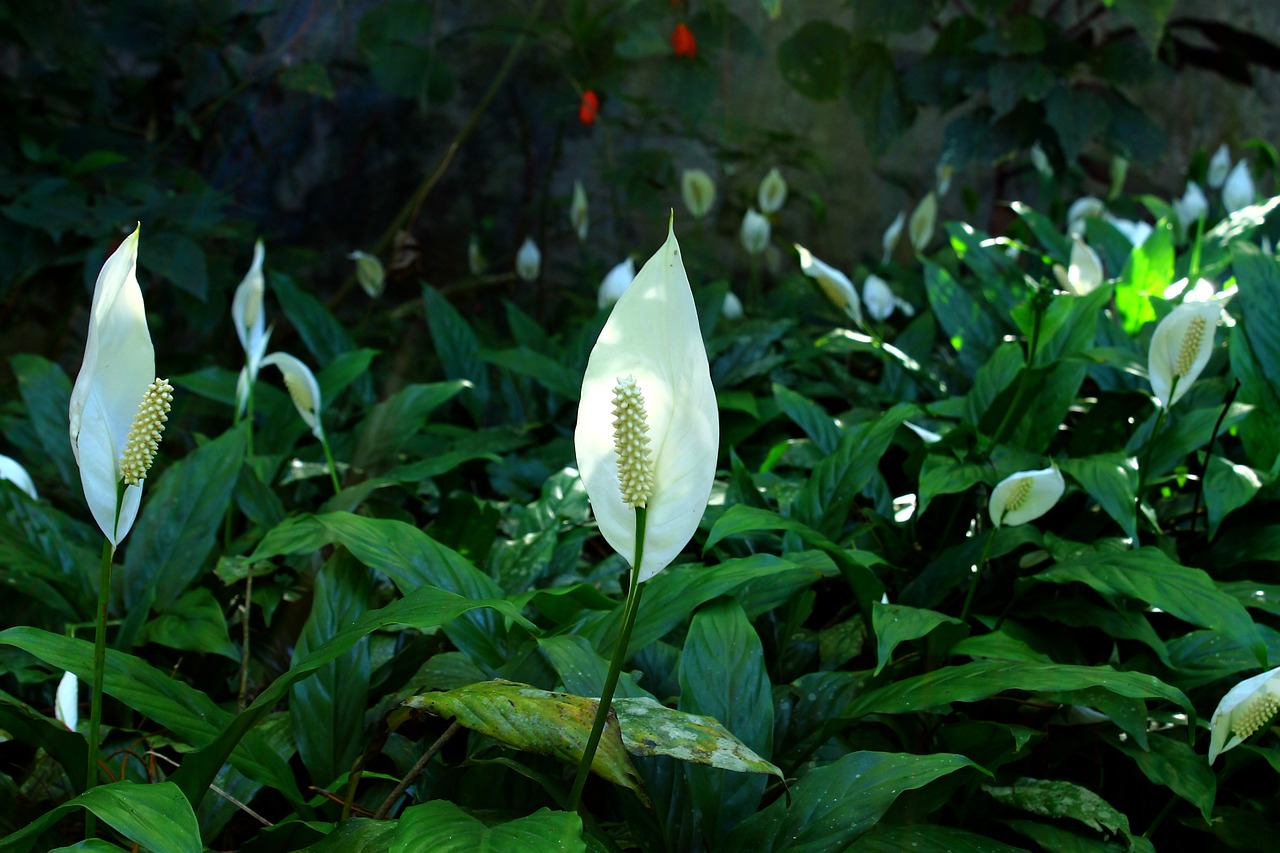
1. Botanical Details and Varieties:
- Botanical Info:
- Family: Araceae
- Genus: Spathiphyllum
- Common Names: Peace Lily, Spathy, White Sails
- Types and Varieties:
- Spathiphyllum wallisii (most common)
- Other varieties include ‘Domino’, ‘Mauna Loa’, and ‘Sensation’ among others.
2. Ideal Growing Conditions:
- Light:
- Prefers bright, indirect light but can tolerate low light
- Avoid direct sunlight to prevent leaf burn
- Temperature:
- Ideal temperature range: 65-80°F (18-27°C)
- Sensitivity to cold drafts (avoid temperatures below 50°F/10°C)
- Humidity:
- Prefers moderate to high humidity (ideal for bathrooms and kitchens)
- Can tolerate average indoor humidity but thrives with a little extra moisture
- Soil:
- Well-draining, peat-based potting mix
- Importance of soil that retains some moisture but doesn’t stay soggy
3. Watering and Fertilizing:
- Watering:
- Water when the top inch of soil feels dry
- Peace Lily’s drooping leaves as a sign of thirst (helpful indicator!)
- Avoid overwatering and ensure good drainage to prevent root rot
- Fertilizing:
- Fertilize during the growing season (spring and summer) with a balanced liquid fertilizer
- Reduce or stop fertilizing in the winter months
- Peace Lilies are light feeders and can do well without frequent feeding
4. Common Issues and How to Fix Them:
- Yellowing Leaves:
- Causes: Overwatering, underwatering, or too much direct sunlight
- Solutions: Adjust watering schedule, improve light conditions
- Brown Leaf Tips:
- Causes: Low humidity, underwatering, or too much direct sun
- Solutions: Increase humidity, keep leaves moist, adjust watering frequency
- Pests:
- Common pests: Spider mites, mealybugs, aphids, and scale
- Natural remedies: Neem oil, insecticidal soap, wiping leaves
- Leaf Drop:
- Causes: Stress from temperature changes, overwatering, or shock from repotting
- Solutions: Stabilize environmental conditions and adjust care routine
5. How to Encourage Blooms:
- Blooms Are Special:
- The white “flowers” are actually spathes (modified leaves) surrounding a spadix (flower spike)
- Peace Lily blooms throughout the year in ideal conditions
- Conditions for Blooms:
- Provide optimal light, temperature, and humidity
- Maintain a consistent watering routine
- Prune spent flowers to encourage new blooms
- What to Do if Blooms Don’t Appear:
- Check for possible care imbalances (light, water, nutrients)
- Be patient—sometimes plants bloom in cycles, not constantly
6. Propagation Tips:
- How to Propagate Peace Lily:
- Best time: During repotting when the plant is mature
- Separate healthy root sections with at least one leaf and repot
- Rooting in Water vs. Soil:
- Can be propagated in water, but soil propagation tends to be more reliable
7. Repotting and Potting:
- When to Repot:
- Signs it’s time to repot (roots are overcrowded, the plant is top-heavy)
- Repot every 1-2 years or when it outgrows its pot
- Best Potting Tips:
- Choose a pot 1-2 inches larger in diameter than the current pot
- Ensure the pot has good drainage to prevent waterlogging
- Repotting Step-by-Step:
- Carefully remove the plant from its pot
- Refresh the soil and check for root health before replanting
- Avoid damaging the roots during repotting
8. Benefits of Owning Spathiphyllum:
- Air Purification:
- Peace Lily is part of NASA’s Clean Air Study; it purifies the air by removing toxins like ammonia, benzene, formaldehyde, and trichloroethylene
- Great for homes and offices to improve air quality
- Aesthetic Appeal:
- Elegant, glossy green leaves with striking white blooms
- Fits well in modern, tropical, or minimalist décor
- Low Maintenance:
- Easy to care for, making it a great choice for beginners
- Tolerates neglect and still thrives
9. Fun Facts About Spathiphyllum:
- Symbolism:
- Peace Lilies are often considered symbols of peace, calm, and prosperity
- Sometimes associated with healing and comfort in Feng Shui
- Name Meaning:
- “Spathiphyllum” comes from the Greek words “spath” (spoon) and “phyllon” (leaf), referring to its distinctive spoon-shaped spathes
10. Additional Resources:
Here’s a list of reputable websites that provide reliable, expert information on Peace Lilies (Spathiphyllum) care as a houseplant:
1. The Spruce
- Website: thespruce.com
- Offers detailed care guides for Peace Lilies, including tips on light, watering, humidity, and troubleshooting common issues.
2. Missouri Botanical Garden
- Website: missouribotanicalgarden.org
- A trusted source for plant care information, providing comprehensive guides on growing, maintaining, and identifying Peace Lilies.
3. Royal Horticultural Society (RHS)
- Website: rhs.org.uk
- The RHS provides authoritative, research-backed plant care guides for houseplants, including Peace Lilies. Their site includes specific advice for growing and troubleshooting this species.
4. University of Florida IFAS Extension
- Website: edis.ifas.ufl.edu
- The University of Florida offers university extension resources that include expert care advice on Peace Lilies, based on horticultural research and best practices.
5. Gardenia.net
- Website: gardenia.net
- Gardenia.net provides a range of information on houseplant care, including Peace Lilies. Their guides cover everything from light requirements to common pests and diseases.
6. Plant Care Today
- Website: plantcaretoday.com
- This site offers practical advice and care tips for Peace Lilies, covering topics such as watering, fertilization, and troubleshooting common problems.
7. Houseplant Central
- Website: houseplantcentral.com
- Houseplant Central provides clear and expert-level guidance on Peace Lily care, including how to maintain optimal conditions for flowering and healthy growth.
8. Dave’s Garden
- Website: davesgarden.com
- A popular community-driven resource where gardeners share personal experiences and advice on plant care, including Peace Lilies.
9. Better Homes & Gardens
- Website: bhg.com
- Better Homes & Gardens offers practical tips on indoor gardening, including specific care advice for Peace Lilies and how to keep them thriving in your home.
10. The Sill
- Website: thesill.com
- An online plant shop with expert advice and care guides, The Sill provides useful, easy-to-follow tips for keeping Peace Lilies healthy and thriving in your home.
These websites are trusted by both amateur and experienced plant lovers for accurate, researched-based information on Peace Lily care. Whether you’re a beginner or looking for advanced tips, these sources have you covered.

